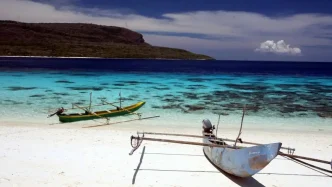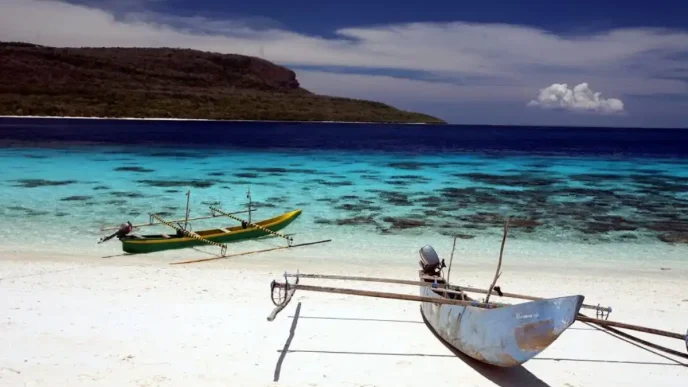A devastating ferry accident in the Bali Strait has claimed at least six lives, with dozens still missing, after the Tunu Pratama Jaya ferry sank late on Wednesday night while en route from Ketapang Port in Banyuwangi, East Java, to Gilimanuk Port in Jembrana, Bali. Rescue operations, battling strong currents and towering waves, continue to search for survivors in one of Indonesia’s busiest maritime corridors.
A Midnight Disaster Unfolds
The Tunu Pratama Jaya ferry departed Ketapang Port at 10:56 p.m. on Wednesday, carrying 53 passengers and 12 crew members. Just 24 minutes into its journey across the Bali Strait, the vessel issued a distress call, reporting a critical leak in its engine room. By 11:35 p.m., the ferry had lost all power, capsized, and began drifting southward, with its last known position recorded approximately 2.7 kilometers from Ketapang Port.
Rescue efforts were mobilized immediately, involving a joint operation of Search and Rescue personnel from Bali and East Java, port authorities, local military units, police, and volunteers. As of Thursday evening, 30 survivors had been located, many of whom swam to shore or were rescued by local fishermen along Bali’s southern coast, from Gilimanuk Beach to Melaya Beach and Pebuahan Beach in Jembrana’s Negara District. The bodies of six individuals have been recovered and transported to Negara Regional Hospital in Jembrana Regency for identification and examination.
“We have also deployed 13 underwater rescue specialists, along with nine ships and a helicopter, to assist in the search” said Air Vice Marshal Mohammad Syafi’i, head of Indonesia’s National Search and Rescue Agency, on Thursday. He added that the operation faced significant challenges due to strong ocean currents and waves reaching up to 2.5 meters. Authorities have called on fishermen and passing vessels in the Bali Strait to stay alert and report any signs of survivors or wreckage.
Survivors and the Struggle to Safety
Many of the survivors endured harrowing ordeals to reach safety. According to Nanang Sigit, head of the Surabaya Search and Rescue Agency, most were found scattered along several points on Bali’s southern coast. “They were found along several points on Bali’s southern coast, from Gilimanuk Beach to Melaya Beach and Pebuahan Beach in Jembrana’s Negara District” he said on Thursday. The resilience of local fishermen, who played a critical role in rescuing survivors, has been a small beacon of hope amid the tragedy.
Yet, the scale of the disaster remains unclear as dozens are still unaccounted for. The search area has been widened, with rescuers combing both the waters of the Bali Strait and the surrounding coastal regions. The urgency of the operation is palpable, as every passing hour reduces the likelihood of finding additional survivors in the treacherous conditions.
Investigating the Cause: A History of Maritime Mishaps
The National Transportation Safety Committee (KNKT) has launched an investigation into the sinking of the Tunu Pratama Jaya ferry. KNKT head Soerjanto Tjahjono, along with two investigators, is traveling to Bali to examine the circumstances surrounding the accident. “There are reports that the ferry experienced a leak in its engine room before it sank. We will verify those reports. We will also examine the vessel’s docking records and maintenance history and interview surviving crew members” Tjahjono said, as quoted by Kompas.id on Thursday.
Tjahjono expressed hope that the findings would help prevent future accidents, noting that this is not the first ferry disaster in the Bali Strait. In March 2016, the Rafelia 2 ferry sank in the same strait, carrying 76 people and resulting in seven fatalities. Another tragic incident occurred in December 2021, when the Yunicee ferry capsized, leaving seven dead and 18 passengers still missing to this day.
The Bali Strait, despite its relatively narrow width of about 8 kilometers and an average depth of 50 meters, poses significant navigational hazards due to its unpredictable and powerful currents. “The currents can swiftly shift direction between north and south because of tidal influences from both the Indian Ocean and the Java Sea. During these tidal changes, the currents become exceptionally powerful” Tjahjono explained. He cited the Yunicee ferry accident as an example, where the vessel drifted far south within minutes after sinking due to these tidal forces.
Systemic Issues in Maritime Safety
Beyond the immediate causes of the Tunu Pratama Jaya sinking, experts point to broader systemic issues in Indonesia’s maritime safety framework. Setyo Nugroho, dean of the Faculty of Marine Technology at Sepuluh Nopember Institute of Technology (ITS) Surabaya, highlighted that cargo-related issues account for 80 percent of ship accidents worldwide. “Improper stability calculations can significantly affect a vessel’s behavior under certain conditions. However, this issue alone rarely causes accidents. Other factors, such as technical flaws in the hull or engine, leaks, and human elements like fatigue, which can reduce concentration, usually also contribute to such incidents” he said.
Nugroho further elaborated on the compounding nature of maritime accidents, describing them as a result of the “Swiss cheese effect” where multiple layers of failure align to create a disaster. While he acknowledged that marine safety regulations in Indonesia are adequate on paper, he criticized the lack of enforcement and monitoring. “Marine safety regulations in Indonesia are adequate; however, enforcement and monitoring remain lax, with many industry players failing to comply with the rules” he noted.
This tragic incident raises critical questions about the state of maritime infrastructure and oversight in Indonesia, a nation of over 17,000 islands where ferries are a lifeline for millions. The recurring nature of such accidents in the Bali Strait underscores the urgent need for stricter compliance with safety standards, improved vessel maintenance, and enhanced training for crew members to handle emergencies in challenging conditions.
The Human Cost and Regional Impact
The sinking of the Tunu Pratama Jaya ferry is not just a statistic; it is a profound human tragedy. Families in Banyuwangi and Bali await news of their loved ones, grappling with uncertainty as rescue teams work tirelessly against the odds. The Bali Strait, a vital link between the islands of Java and Bali, serves as a key route for both locals and tourists, particularly those heading to Bali, one of Indonesia’s most popular resort destinations. An accident of this nature could have ripple effects on public confidence in ferry services, potentially impacting local economies that rely heavily on tourism and inter-island connectivity.
For global readers, it’s worth noting that Indonesia’s maritime transport system faces unique challenges due to the country’s archipelagic geography. Ferries often operate in areas with limited infrastructure for rapid emergency response, compounded by natural hazards like strong currents and seasonal weather patterns. The Bali Strait, in particular, is a notorious bottleneck where tidal forces from two major bodies of water—the Indian Ocean and the Java Sea—collide, creating unpredictable conditions for even the most seasoned mariners.
Looking Ahead: Can Lessons Be Learned?
As the search for the missing continues, attention is already turning to how such tragedies can be prevented in the future. The KNKT investigation will likely scrutinize not only the technical aspects of the Tunu Pratama Jaya’s sinking but also the broader operational and regulatory environment in which it occurred. If issues like poor maintenance, inadequate crew training, or lax enforcement are found to have contributed, there will be renewed calls for reform in Indonesia’s maritime sector.
Public and political pressure may also mount for greater investment in safety infrastructure, such as improved weather monitoring systems and faster emergency response capabilities in high-risk areas like the Bali Strait. For now, though, the focus remains on the ongoing rescue efforts and supporting the families affected by this disaster.
As the investigation unfolds and rescuers battle the elements, one question looms large: will this tragedy finally spur the systemic changes needed to safeguard lives on Indonesia’s waterways, or will the Bali Strait claim more victims in the years to come?
















